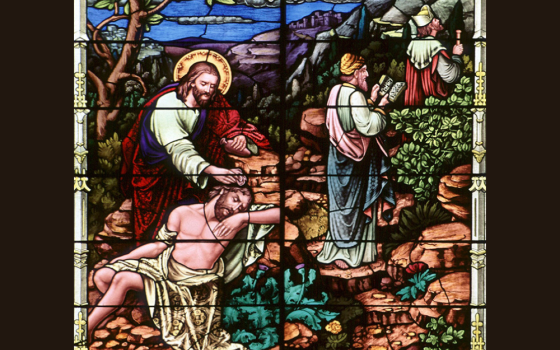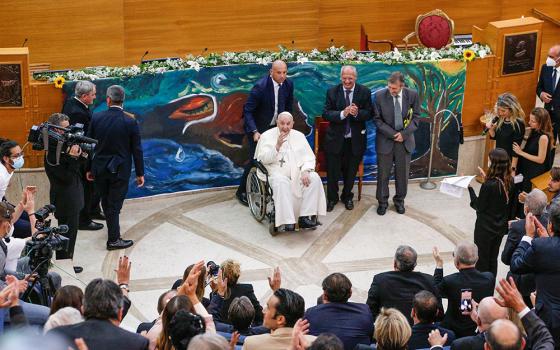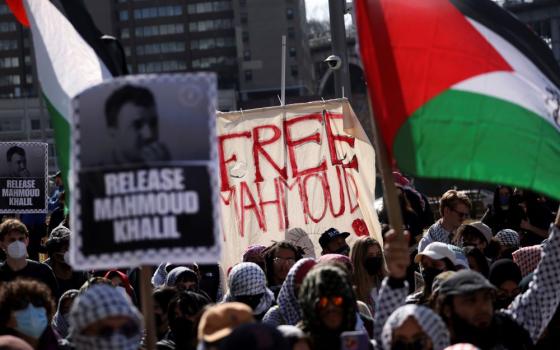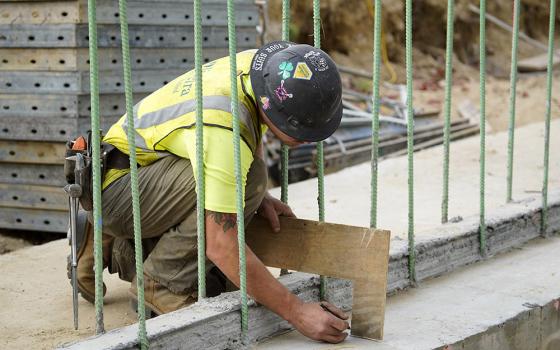
Pope Francis poses for a selfie during a gathering of youth delegates at the Pontifical International Maria Mater Ecclesiae College in Rome, ahead of the Synod of Bishops on young people in 2018. (CNS/Vatican Media)
Ecclesial synodality is something very old and, at the same time, something very recent. It is an integral part of the tradition of the Church.
As the report of the International Theological Commission, Synodality in the Life and Mission of the Church (2018), says in the opening section: " 'Synod' is an ancient and venerable word in the Tradition of the Church, whose meaning draws on the deepest themes of Revelation."
But the theology of synodality, which is now at the basis of Pope Francis' push for a synodal reform of the Church, is something that has developed in the aftermath of the Second Vatican Council (1962-65).
The final documents of Vatican II never used the term "synodality", even though the ecclesiology of the Council opens to that perspective.
The modern theology of synodality originates chronologically in contemporary theology of the Catholic Church, and geographically within societies in the liberal-democratic order in the Western hemisphere. This is not just a coincidence.
A key factor for the future of synodality is the relationship between Christianity and the different social and political — and not only ecclesial or theological — traditions around the world, in a community as global as the Catholic Church today.
The connection between the emergence of synodality and the Church's efforts to rebuild its credibility from the sexual abuse crisis is hard to miss in places like Germany, Australia and Ireland.
Location is everything: Germany compared to the United States
There are, in the background, different models of synodality at work. It's a matter of ecclesial models, all of them in a deep relationship with particular kind of arrangements between Church, State and society.
The "Synodal Path" in Germany reflects the particular role of Catholicism as an established Church enjoying particular constitutional provisions, but also has a precedent in a very important post-conciliar experience in then Federal (Western) Republic of Germany: the national synod, the so-called "Wurzburg Synod", of 1971-1975.

Auxiliary Bishop Karlheinz Diez of Fulda, Germany, speaks Jan. 31, 2020, with synodal assembly participants in Frankfurt. (CNS/KNA/Harald Oppitz)
There is no such institutional ecclesial memory of a recent synodal event, for example, in the United States where the defining national ecclesial assembly is much more the Third Plenary Council of Baltimore in 1884 than the post-Vatican II attempts.
The US Church's experience of the 1970s vanished into thin air and respect for synods declined.
Another difference from Germany is the difficulty that US Catholicism is having in leaving behind a sort of clericalism tied to racism and patriarchalism, as well as its challenge in responding to the hyper-individualism of American life.
"A lot of Americans have seceded from the cultural, political and social institutions of national life," said New York Times columnist David Brooks in a recent article on the pandemic.
And it must be noted that the Catholic Church in the United States is not exempt from this same phenomenon of distrust.
The Italians, Latin Americans and the Church 'Down Under'
The prospects for a synod in Italy find its historical precedent in the 1970s as well. It can be dated back to the "ecclesial conference" on evangelization and human promotion that the Italian Episcopal Conference (CEI) gathered in 1976 — two years before John Paul II was elected pope.
The chronological jump back to Paul VI is evident even in the argument made by the Italian Jesuits, who have played an important role in helping the current members of the CEI embrace the invitation Pope Francis issued back in 2015 to set a national synodal process in motion.
Latin America provides a different example, especially through the continental assemblies of CELAM (the Council of Latin American Episcopal Conferences) and, in particular, the assembly held in 1968 in Medellin.

Bishops gather near the apostolic nunciature prior to the start of Pope Francis' meeting with the executive committee of the Latin American bishops' council (CELAM) in Bogotá, Colombia, Sept. 7, 2017. (CNS/Paul Haring)
The Catholic Church in Australia is currently preparing its first Plenary Council since 1937. It must be seen in the context of the ecclesial listening style of the lay-run "Truth, Justice and Healing Council" that Australia's bishops set up to respond to the "Royal Commission into Institutional Response to Child Sexual Abuse" (2013-2017).
But this Plenary Council can also count on an ecclesial culture that has taken stock of decolonization and inculturation deeper than other Churches in the Anglo-Western hemisphere.
In chronological terms, it actually preceded the "Royal Commission" and even the election of Pope Francis. It is not dependent on a legislative/parliamentary model. And this is why Archbishop Mark Coleridge, the president of the national episcopal conference and leader of the Plenary Council, is not apoplectic about the prospects of Germany's "Synodal Way".
Asia, Africa and the place where it all began
The picture is different when we try to understand the ecclesial models in the background for the Catholic Church in Asia, Africa and the Middle East.
It is an emerging Church. But often it is also a Church that being persecuted or pressured because of its minority status.
Sometimes this is within a system of authoritarian secularity. Other times it is situated in a fragile coexistence with the rise of sectarian and nationalist ideologies based on religion, like the particular ideological version of Hinduism being pushed in Modi's India.

Cardinals Baselios Cleemis Thottunkal of Trivandrum, India, major archbishop of the Syro-Malankara Catholic Church, walks to his seat during an event marking the 50th anniversary of the Synod of Bishops in Paul VI hall at the Vatican Oct. 17, 2015. (CNS/Paul Haring)
What will synodality look like in a context where Catholicism plays a particular role on the issue of the caste system like India, for example?
What will it look like in mainland China and in Hong Kong, where social and political engagement makes religious groups, including Catholics, a target of government repression? Or in Indonesia, where the relations between secular law and Islam are significantly diverse in different areas of that country, the most populous Muslim country in the world?
What does it mean to intersect a synodal model with the post-colonial relations between Church and State in a continent like Africa? Or in the Middle East, where the Church is in a situation of fragmentation and fragility augmented by the consequences of thirty years of Western military interventions?
This is important for the future of synodality.
Who and what are the driving forces of synodality today?
The pope's stern warning to avoid turning synods into parliaments should not be interpreted as a defensive attitude by the ecclesiastical institution. Rather, it should be seen as a realistic response to the current situation of the global Church where the parallel synodality-parliamentarism is rife with problems.
And it's not just a problem in the Churches of the global south, if one considers the crisis of democracy and of democratic culture also among Catholics in the United States.
Synodal Church means ecclesial processes that are less centered on the clergy and more open to the leadership role of the laity, especially women. But the big question is who and what are the driving forces of synodality. And the answer is complex.
What are the social alliances at the center of ecclesial synodality in the 21st century? What classes or class fragments are allied with the Church turning to synodality?
What sections of the Church or specific actors are at the center of the synodal movement? What organizations and networks?
Advertisement
Something like the Central Committee of German Catholics, which — together with the bishops' conference — is at the center of the "Synodal Path", exists only in Germany.
What are the ruling models in people's heads and where do they come from? How are they shaped by class alliances? The owning class, the professional managerial class, the technical-bureaucratic class, the working class, the poor?
For example, Francis is a Jesuit and his idea of synodality, with discernment at the center, reflects his Jesuit formation and identity.
At the same time, if one looks at the history of the pope's 16th century religious order, it is evident that its class alliances have evolved from the European elites in early modern period to the turn to social change in the post-Vatican II period.
It is not just an issue for the global Church far from Europe. On the Old Continent, the synodal experiences in Germany, Italy and Ireland are in the context of an established Church. The Church is still a pillar of those countries, even in the context of secularization.
But is synodality the beginning of a transformation from pillar to a different form of presence?
(This is one of the reasons the purely sociological measures used to understand the Church remain fundamentally Protestant and Anglo-American and there for inadequate to comprehend global Catholicism.)
Synods are not parliaments, and yet ...
Synodality is a way of engaging institutional and ecclesial connections by another means. And this is crucially important in a time of anger and detachment vis-à-vis institutions; at a time when institutions are automatically cast as evil.
But the future of synodality depends also on the ability to understand that the preparation, celebration and reception of a synod for the Catholic Church takes different shapes.

Pope Francis leads a session of the Synod of Bishops for the Amazon at the Vatican Oct. 15, 2019. (CNS/Paul Haring)
It was different in an imperial Church (like in the early centuries until the Middle Ages) than it was in a European or colonial Church (as in the early modern and modern period).
And it will be different in today's global Church where the relationship between the ecclesial order and the social, political and economic orders is made of many different models.
Francis has warned repeatedly since October 2015 against the temptation to see synods as parliaments of the Church.
Yet, the Church currently looks like a parliament with many voices. It's not simply the projection of political ideas on the Church.
Contemporary men and women are themselves, each one of them, a parliament with many voices, as German Benedictine theologian Elmar Salmann said recently at an important conference on the future of theology organized by the John Paul II Pontifical Theological Institute in Rome.
It would be naïve to separate the current Catholic conversation on ecclesial synodality from the sensibility of the homo democraticus — men and women steeped in the culture of human rights, communicative dissent and, most of all, egalitarianism.
But this is happening in a global context where the connection between the Church and the culture of participation and inclusion takes significantly different shapes.
Editor's note: This article originally appeared on La Croix International.








